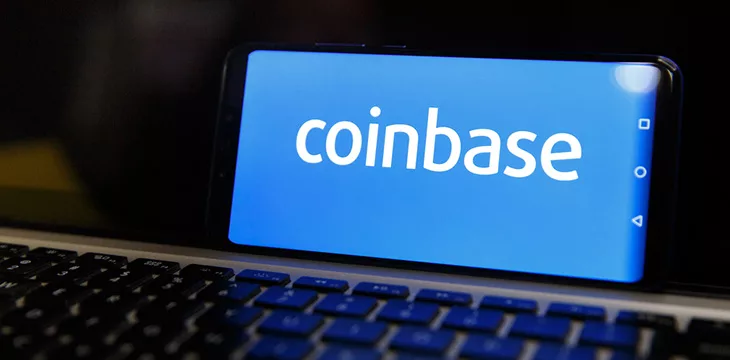|
Getting your Trinity Audio player ready...
|
Coinbase (NASDAQ: COIN) has been hit with an insider trading lawsuit just as the digital asset exchange’s CEO Brian Armstrong dumped another $1.65 million worth of his shares.
On April 24, Armstrong sold nearly 30,000 shares in the company he oversees, pushing his year-to-date sales to over $23 million. Since the year began, only one company principal—Director Tobias Lutke—has purchased Coinbase shares, while four other C-suite execs besides Armstrong have dumped holdings. In fact, you have to go back almost 12 months to find any insider other than Tobias purchasing Coinbase stock.
Such activity is the basis behind a civil suit filed this week in the Court of Chancery of the State of Delaware by Adam Grabski, a verified Coinbase stockholder. Grabski’s suit targets Armstrong, co-founder Fred Ehrsam III (also the founder of investment firm Paradigm), past and present Coinbase execs Surojit Chaterjee, Emilie Choi, Alesia Haas, and Jennifer Jones, as well as investors Marc Andreessen (a16z), Kathy Haun (ex-a16z) and Fred Wilson (Union Square Ventures).
The gist of the suit is that Coinbase’s April 14, 2021, listing on the Nasdaq exchange took the form of a direct listing rather than the more typical initial public offering (IPO). The direct listing avoided any trading ‘lock-up’ restrictions, thereby allowing insiders to unload over $2.9 billion worth of their shares in the week following the listing.
Opting for a direct listing also alleviated the need for an underwriter to conduct due diligence on a company’s fiscal health. The suit claims the company opted for the direct listing rather than an IPO because insiders were “focusing on the benefits to existing investors rather than the Company itself.”
The suit accuses the insiders of possessing material non-public information, including the knowledge that Coinbase would need to issue additional shares to raise over $1 billion in capital just one month after the direct listing. The surprise announcement of this dilutive fundraising on May 18, 2021, coupled with a disappointing Q1 earnings report, caused Coinbase’s share price to crater, eliminating $37 billion in market cap. (The stock currently trades around 85% below its $381 listing price.)
The suit alleges that Coinbase insiders were aware that a growing number of exchange customers were opting for the Coinbase Pro option, leading to a “negative turn” in the retail trading commissions that had been the company’s “principal growth driver.” Hiding this information from investors before the listing enabled the defendants to avoid $1.09 billion in losses.
The suit claims that Coinbase directors were aware of their need to raise additional capital as early as December 2020 but chose to “deprioritize” this action to “minimize dilution” of directors’ existing holdings in the company.
The suit details the extent of the insider sell-off, led by director Wilson’s Union Square, with over $1.8 billion unloaded in connection with the direct listing. The other insiders’ tallies for the period in question are only slightly less egregious:
- Brian Armstrong (CEO/co-founder – $291.8 million)
- Emilie Choi (Chief operating officer/president – $224 million)
- Fred Ehrsam III (director/co-founder – $219.5 million)
- Marc Andreessen (director, a16z co-founder – $118.65 million)
- Alesia Haas (Chief financial officer – $99.3 million)
- Surojit Chatterjee (Chief product officer – $61.9 million)
- Kathy Haun (director, former a16z general partner – $52.6 million)
- Jennifer Jones (Chief accounting officer – $43.4 million)
Given the example set by the above senior figures, is it any wonder that a Coinbase mid-level staffer recently pleaded guilty to insider trading on advance knowledge of which utility-devoid meme coins were to be listed on the exchange?
Go deep, go broad, go away
Speaking of aping bad behavior, Tuesday saw the launch of Coinbase International Exchange, the Bermuda-based trading platform that offers perpetual futures contracts on BTC and ETH to “non-US institutions in select jurisdictions.”
Retail customers, at the moment, cannot access these forbidden crypto fruits, but the site expects to eventually roll out the welcome mat for “non-US professional investors and advanced retail users in eligible countries.”
Initially previewed last month, Coinbase’s Bermuda offshoot aims to tap into the high-leverage/high-risk trades currently dominated by rival exchange Binance. However, while Binance once offered customers the ability to multiply their bets by over 100x, Coinbase’s new site is (again, for the time being) capping leverage at 5x.
All trading on the new exchange is conducted via USDC, eliminating the need for fiat on-ramps. But that does require customers to buy the USDC stablecoin, which is issued by Circle (via the Centre consortium, in which Coinbase and Circle are the only partners). USDC has undergone significant shrinkage in recent weeks, its market cap falling by $13 billion since mid-March, so all avenues of propping up this falling star must be vigorously explored.
Coinbase justified the launch of its new site by stating its desire to “update the financial system by building trusted products that expand the utility and adoption of crypto.” That’s right! High-rolling gamblers previously limited to betting on blackjack can now wager their wads on roulette and crypto craps games as well! Such utility. Much adoption.
Coinbase stressed that it remains “committed to the US, but countries around the world are increasingly moving forward with responsible crypto-forward regulatory frameworks to strategically position themselves as crypto hubs. We would like to see the US take a similar approach instead of regulation by enforcement which has led to a disappointing trend for crypto development in the US.”
Coinbase recently sued the U.S. Securities and Exchange Commission (SEC) in an attempt to force the regulator to respond definitively to the petition Coinbase filed last July. That petition asked the SEC to “propose and adopt rules to govern the regulation of securities that are offered and traded via digitally native methods, including potential rules to identify which digital assets are securities.”
But as SEC chair Gary Gensler has repeatedly pointed out, existing securities laws are quite clear that most digital assets meet the criteria for identifying a security. As Gensler told the House Financial Services Committee last month, “Not liking the message isn’t the same thing as not receiving it.”
Similar to how Coinbase shareholders didn’t much like the message the company sent by withholding evidence of a faltering business model until after insiders dumped their shares. Still, we’re guessing shareholders received Armstrong & Co’s message loud and clear.
Unstaked through the heart
Coinbase has been more or less forced into its ‘global expansion strategy’ based on its shrinking balance sheet. The company’s most recent annual report showed a net loss of $2.6 billion, and the situation hasn’t improved much since then.
Coinbase will release its Q1 earnings report Thursday, and while the banking failures that dented USDC’s status were only just getting started in the quarter’s final weeks, the numbers still aren’t expected to be pretty.
Last year, Coinbase’s few remaining growth verticals were led by its ‘blockchain rewards’ segment, but the recent ‘Shanghai’ upgrade of the Ethereum blockchain—which allowed ETH stakers the ability to finally unwind their stakes and withdraw their deposits—has led to a net outflow of nearly $400 million from Coinbase since April 12.
Much of this outflow is headed towards so-called decentralized staking protocols, which can offer higher yields on staked assets. American customers have also been spooked after the SEC forced the Kraken centralized exchange to forego its staking programs due to the regulator’s view that the product was an unregistered security. (Shortly thereafter, the SEC put Coinbase on notice regarding its own unregistered offerings.)
Also, the MakerDAO community recently renegotiated its deal with Coinbase to force the exchange to boost the paltry 1.5% interest rate it had been paying community members to custody their assets. This will cut into another rare bright spot on Coinbase’s revenue chart and will take a further hit when MakerDAO launches its own self-custodial solution within the year.
Neither a borrower…
Wednesday brought word that Coinbase customers “will no longer be able to take out new loans with Coinbase Borrow,” effective May 10. A notice sent to customers indicated that there would be “no impact on your outstanding loans and there is no action required at this time.”
The little-known Coinbase Borrow program allowed users in 23 U.S. states to borrow up to $1 million using BTC as collateral at an annual rate of 8.7% interest. The company has yet to explain publicly why the program is being mothballed, but its most recent 10-K filing offers some possible clues.
Coinbase notes that lending cash to customers “results in us being subject to certain lending laws and regulations in the applicable jurisdiction and as a result we may be subject to additional regulatory scrutiny.” And that is the last thing that Coinbase really wants right now.
Perhaps more ominously, Coinbase admits that it might sometimes borrow cash from banks to provide loans and that “any termination or interruption in the financial institutions’ ability to lend to us could interrupt our ability to provide capital to qualified customers to the extent we rely on such credit lines to continue to offer or to grow such products.”
The above suggests the possibility that the recent U.S. banking hiccups may have impacted Coinbase beyond the hit to USDC’s reputation for temporarily slipping its 1:1 peg with the U.S. dollar. There’s also the news of Borrow’s demise came one day after MicroStrategy (NASDAQ: MSTR) stated that it had a deal with Coinbase to buy BTC on credit.
The launch of Coinbase’s international exchange and products deemed out of bounds in the U.S. is a fiscal Hail Mary pass intended to snatch victory from the jaws of defeat. But taking market share from crypto derivatives leader Binance won’t be easy. Doing so will likely force Coinbase to engage in the same kind of shenanigans that have made Binance’s name synonymous with illegality.
And just wait until Coinbase’s screening procedures fail to stop U.S.-based customers from accessing these (locally) illegal derivative products. Advice for any Coinbase investor who hasn’t yet sold their stock: keep a sharp eye out for (a) ‘For Sale’ signs suddenly going up on the lawn of the garish $133 million mansion Armstrong bought with his direct listing proceeds and (b) Armstrong suddenly tweeting about how lovely the weather is in Dubai. Don’t say you weren’t warned.
Follow CoinGeek’s Crypto Crime Cartel series, which delves into the stream of groups—from BitMEX to Binance, Bitcoin.com, Blockstream, ShapeShift, Coinbase, Ripple,
Ethereum, FTX and Tether—who have co-opted the digital asset revolution and turned the industry into a minefield for naïve (and even experienced) players in the market.

 08-15-2025
08-15-2025 





